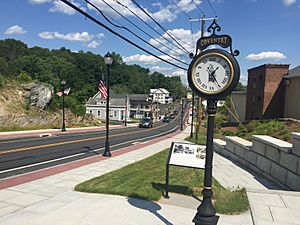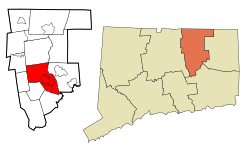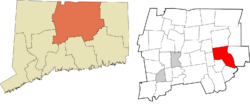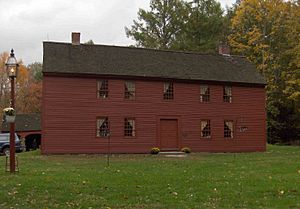Coventry, Connecticut facts for kids
Quick facts for kids
Coventry, Connecticut
|
|||
|---|---|---|---|
| Town of Coventry | |||

The center of South Coventry, nearby Coventry Lake
|
|||
|
|||
 Tolland County and Connecticut Tolland County and Connecticut |
|||
| Country | |||
| U.S. state | |||
| County | Tolland | ||
| Region | Capitol Region | ||
| Incorporated | 1712 | ||
| Government | |||
| • Type | Council-Manager | ||
| Area | |||
| • Total | 38.4 sq mi (99.5 km2) | ||
| • Land | 37.7 sq mi (97.7 km2) | ||
| • Water | 0.6 sq mi (1.7 km2) | ||
| Elevation | 656 ft (200 m) | ||
| Population
(2020)
|
|||
| • Total | 12,235 | ||
| • Density | 324.5/sq mi (125.2/km2) | ||
| Time zone | UTC−5 (EST) | ||
| • Summer (DST) | UTC−4 (EDT) | ||
| ZIP Code |
06238
|
||
| Area code(s) | 860/959 | ||
| FIPS code | 09-17800 | ||
| GNIS feature ID | 0213413 | ||
Coventry (/ˈkɑːvəntri/ kah-VƏN-tree) is a town in Tolland County and in the Capitol Planning Region, Connecticut, United States. In 2020, about 12,235 people lived here. Coventry is famous as the birthplace of Captain Nathan Hale, a hero from the American Revolutionary War. You can visit his home, the Nathan Hale Homestead, which is now a museum.
Contents
History of Coventry
Coventry was given its name in October 1711. It was the first town in the American colonies to be named "Coventry," after the city of Coventry in the West Midlands, United Kingdom.
Early Settlement and Founding
An important road called the Middle Post Road passed through Coventry. This road was created in 1671 to connect the colonies of New York and Massachusetts. The Middle Post Road helped connect Hartford and Boston, going through towns like Coventry.
The first house in Coventry was built near Wangumbaug Lake by Nathaniel Rust from Hartford. His family and about a dozen other families moved to Coventry in 1709. Some of the first settlers included David Lee, Thomas Root, and Samuel Gurley.
The land for Coventry was originally given to men from Hartford by a Native American leader named Joshua. In 1706, the Connecticut General Assembly chose a committee to plan the town and divide the land. In 1711, Nathaniel Rust joined this committee, and they also worked to find a minister for the town. Coventry officially became a town in Hartford County in 1712. The first church was started in October 1714.
Later, Coventry became part of Windham County in 1726. Then, in 1785, it became part of Tolland County when that county was first created.
St. Mary's Church is a Roman Catholic church in Coventry. It is located at 1600 Main Street.
Coventry Today
The older part of town is called South Coventry. It's located near where Main Street (Route 31) and Stonehouse Road (Route 275) meet. In the 1800s, this area had small factories that used water power from Coventry Lake Brook.
South Coventry Village is a historic area with many old buildings, including Victorian houses. It has a museum, the main public library, and the Bidwell Tavern. The Bidwell Tavern was opened in 1822 and used to keep the town's records and host town meetings! Nearby is the W.L. Wellwood General Store, now called "Coventry Country Store." This store was built in 1787 and is one of the oldest general stores in America. Overall, South Coventry has over 100 historic buildings listed on the national register.
North Coventry is less crowded. Its homes and businesses are newer. In the 1700s, this area was mostly used for dairy and vegetable farms. Many farming families later moved west for better land, and their farms in North Coventry were left behind and became forests. In the 1960s and 1970s, new houses were built on some of this land. More new homes were built after 1990, often larger houses on bigger plots of land.
Geography of Coventry
The town of Coventry covers about 38.4 square miles (99.5 square kilometers). Most of this area, about 37.7 square miles (97.7 square kilometers), is land. The rest, about 0.6 square miles (1.7 square kilometers), is water.
Climate in Coventry
Coventry has a climate with big changes in temperature throughout the year. Summers are warm to hot and often humid. Winters are cold, and sometimes very cold. This type of climate is known as a humid continental climate.
Main Areas of Coventry
- North Coventry
- South Coventry
- Coventry Lake
Population of Coventry
| Historical population | |||
|---|---|---|---|
| Census | Pop. | %± | |
| 1790 | 2,130 | — | |
| 1800 | 2,021 | −5.1% | |
| 1810 | 1,938 | −4.1% | |
| 1820 | 2,058 | 6.2% | |
| 1850 | 1,984 | — | |
| 1860 | 2,085 | 5.1% | |
| 1870 | 2,657 | 27.4% | |
| 1880 | 2,043 | −23.1% | |
| 1890 | 1,875 | −8.2% | |
| 1900 | 1,632 | −13.0% | |
| 1910 | 1,606 | −1.6% | |
| 1920 | 1,582 | −1.5% | |
| 1930 | 1,554 | −1.8% | |
| 1940 | 2,102 | 35.3% | |
| 1950 | 4,043 | 92.3% | |
| 1960 | 6,356 | 57.2% | |
| 1970 | 8,140 | 28.1% | |
| 1980 | 8,895 | 9.3% | |
| 1990 | 10,063 | 13.1% | |
| 2000 | 11,504 | 14.3% | |
| 2010 | 12,435 | 8.1% | |
| 2020 | 12,235 | −1.6% | |
| U.S. Decennial Census | |||
In 2010, there were 12,435 people living in Coventry. The town had 4,783 households. About 31.1% of these households had children under 18 living with them. The average household had about 2.59 people.
The median age of people in Coventry was 41.5 years old. This means half the people were younger than 41.5, and half were older. About 23.3% of the population was under 18 years old.
Fun Places to Visit in Coventry
- Wangumbaug Lake, also known as Coventry Lake, is a large lake covering about 373 acres (1.5 square kilometers). It's fed by natural springs. At Patriots Park on the lake, you'll find a beach with lifeguards, a playground, picnic areas, and a stage for summer concerts. Many rowing teams, including those from UConn, use the lake for practice. In winter, when the lake freezes, people sometimes go skating or ice fishing. There's also a small lake island called Underwood Island not far from the shore.
- Nathan Hale Homestead was first built around 1740. The current house was built in 1776. This is where Nathan Hale was born in 1755. The original Hale farm was about 450 acres (1.8 square kilometers) and is now part of the Nathan Hale State Forest. Today, the Hale family home on South Street is a museum. You can take tours and learn about history. It also hosts a Farmer's market on Sundays in the summer, with food trucks and local businesses.
- The Strong-Porter House Museum was built around 1730. It's listed on the National Register of Historic Places and is the museum for the Coventry Historical Society. You can explore five rooms of the house and several other old buildings, like a carpenter shop and barns.
- The Brick School House was built in 1825 after the first one burned down. It's one of only four old schoolhouses left in Coventry and was used until 1953.
- Caprilands Herb Farm is a colonial farmstead from around 1740. For over 65 years, it was the home of Adelma Grenier Simmons, a famous herbalist and author.
- Hytone Farm has been run by the Peracchio family since the early 1940s and has been a dairy farm since 1960. They raise their own Holstein cows and use over 350 acres (1.4 square kilometers) of land to grow food for them. Hytone Farm has won many awards for its farming.
- Museum of Connecticut Glass is a new museum that teaches about how glass was made in Connecticut.
On the National Register of Historic Places
Many buildings and areas in Coventry are so important that they are listed on the National Register of Historic Places. This means they are protected and recognized for their historical value. Some of these places include:
- Brigham's Tavern – 12 Boston Tpke. (added 1982)
- Capron-Phillips House – 1129 Main St. (added 1982)
- Captain Nathan Hale Monument – 120 Lake St. (added 2002)
- Coventry Glass Factory Historic District – US 44 and N. River Rd. (added 1987)
- Elias Sprague House – 2187 South St. (added 1987)
- Loomis-Pomeroy House – 1747 Boston Tpk. (added 1994)
- Nathan Hale Homestead – 229 South St. (added 1970)
- Parker-Hutchinson Farm – Parker Bridge Rd. (added 1982)
- South Coventry Historic District – Main St. and nearby streets (added 1991)
- Strong-Porter House – 2382 South St. (added 1988)
Annual Events in Coventry
Coventry hosts several fun events each year:
- Memorial Day Parade: This parade honors Captain Nathan Hale and all members of the Armed Forces.
- CoventryFest: Held in early July at Patriot's Park, this festival features fireworks, food, and live music.
- Captain Hale's Birthday Party: Celebrated on June 6th at the Hale Homestead.
- Colonial Encampment and Muster: Held in July by the Nathan Hale Ancient Fife & Drums at the Hale Homestead, showing what colonial life was like.
- "Old-Fashioned Christmas in Coventry": Takes place on the first Saturday in December on Main Street.
Schools in Coventry
Coventry has several schools for different age groups:
- Coventry Grammar School: For students in Kindergarten through Grade 2.
- G. H. Robertson Intermediate School: For students in Grades 3–5.
- Capt. Nathan Hale Middle School: For students in Grades 6–8.
- Coventry High School: For students in Grades 9–12.
- Coventry Academy: For students in Grades 8–12.
Famous People from Coventry
Many interesting people have connections to Coventry:
- George N. Barnard (1819–1902): A photographer who helped record the American Civil War.
- Lorenzo Dow (1777–1834): An important religious figure.
- Elisha W. Edgerton (1815–1904): A businessman and politician in Wisconsin.
- Nathan Hale (1755–1776): A captain in the Continental Army during the American Revolutionary War and an official State Hero of Connecticut. He was born in Coventry.
- David Hayes (1931–2013): A modern artist known for his painted steel sculptures.
- Benoni Irwin (1840–1896): An American portrait painter who spent summers here.
- Jesse Root (1736–1822): A resident who served in the Continental Congress and was a chief justice of the Connecticut Supreme Court.
- Adelma Grenier Simmons (190–1997): An author and a leading expert on herbs in America.
- Allan Sherman (1924–1973): An author who wrote outdoor stories.
Sister Cities
Coventry is connected to other towns named Coventry!
Twin Town
Coventry, Connecticut, is also twinned with Coventry in the United Kingdom. This means they have a special friendship and cultural exchange.
See also
 In Spanish: Coventry (Connecticut) para niños
In Spanish: Coventry (Connecticut) para niños





